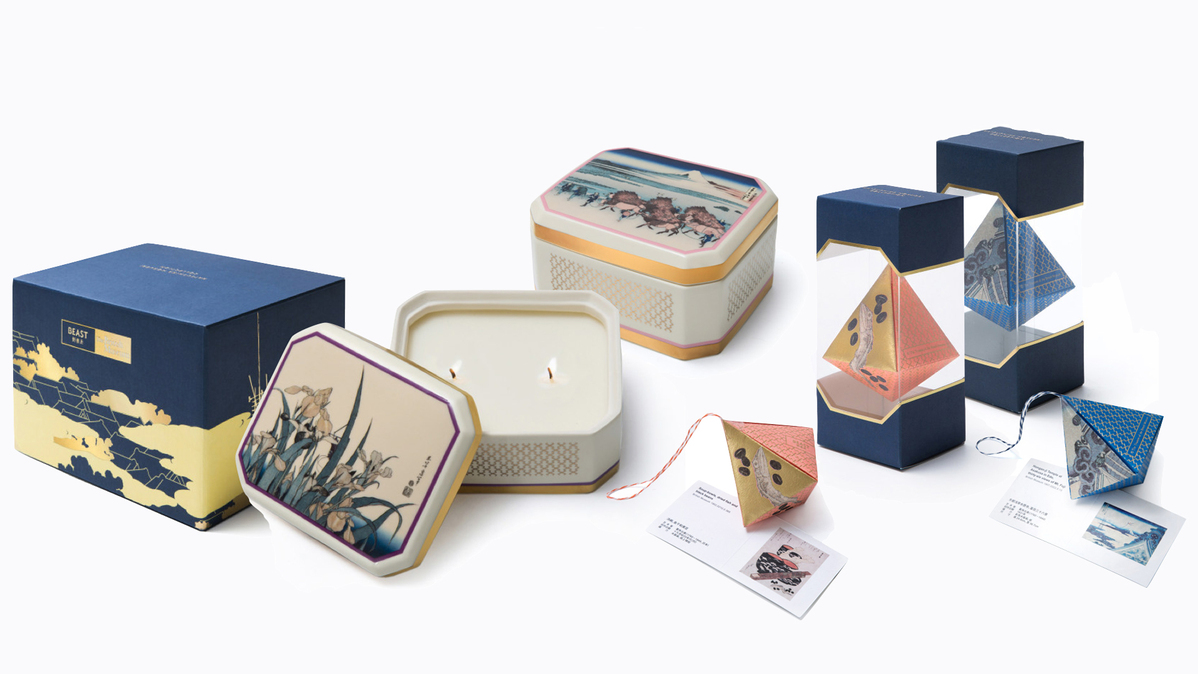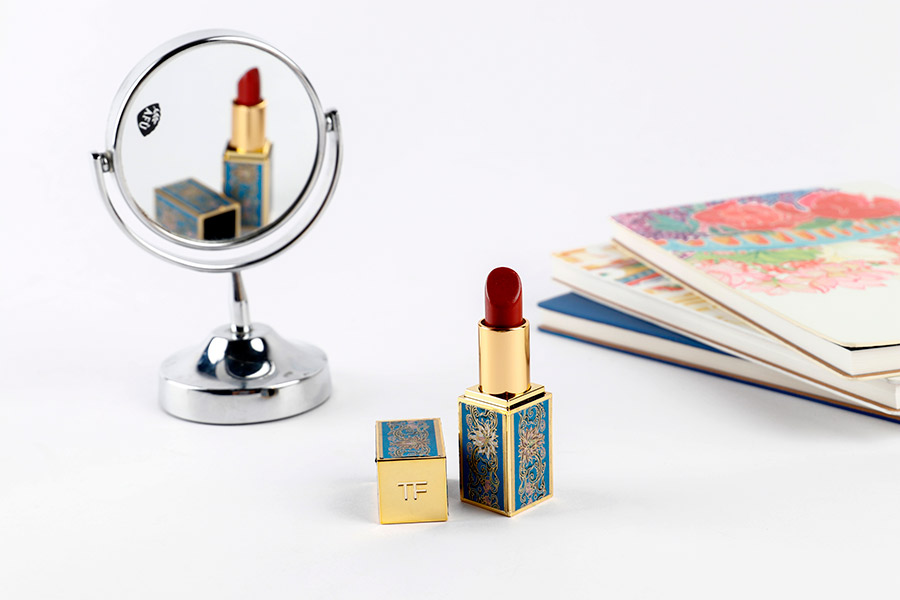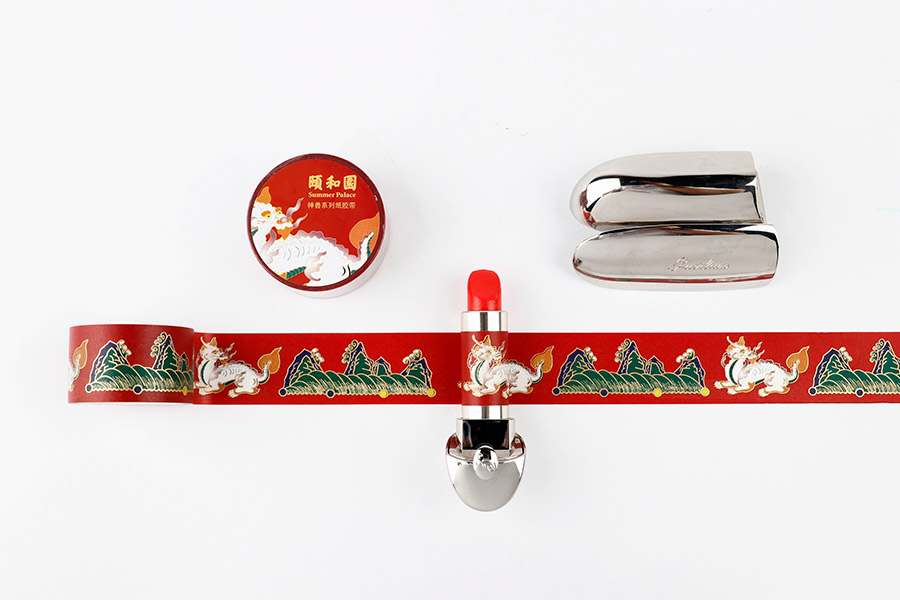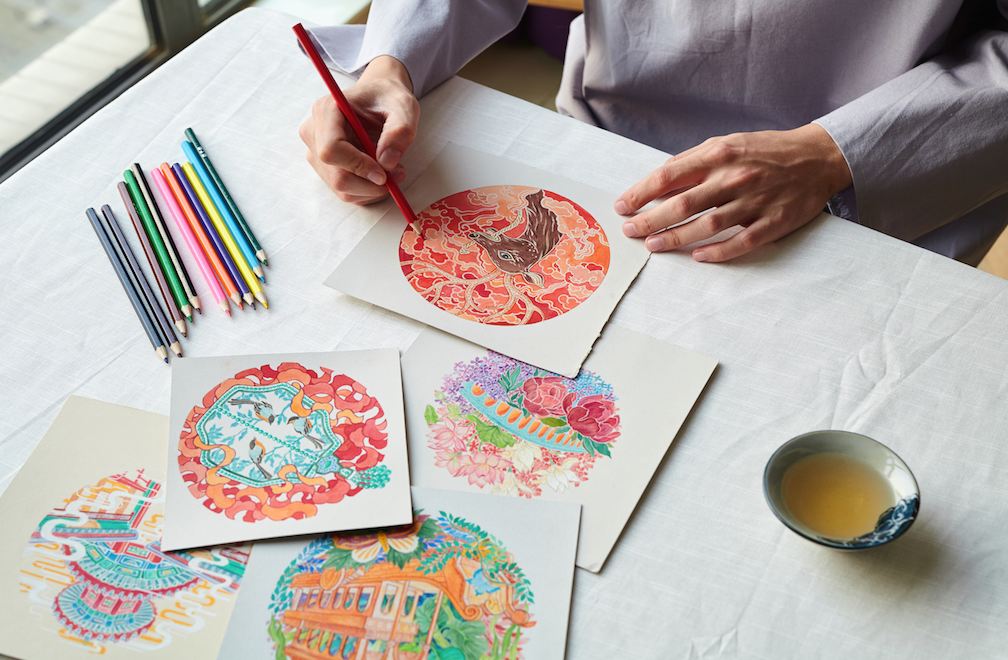
Creative designs and merchandise from the British Museum. (Photos: China Daily)
Nation's prosperous creative and cultural industry thriving
When the British Museum opened its online store on Alibaba's marketplace Tmall on July 1, more than 50 types of products based on the institution's iconic collection sold out within days.
Revenue amounted to more than 1 million yuan ($146,000) and the store attracted about 160,000 fans in just one month.
Sales were beyond the expectations of both the museum and its Chinese licensee partner, Alfilo Brands Co.
"We'd anticipated the museum's online store being a success but never thought it would be so big," said He Yizan, the CEO of Alfilo, which operates the online shop.
The bulk of the products that sold out, such as teacups, bags and fans, were tailored solely for the Chinese market.
They were inspired mainly by the museum's Egyptian collections and the Rosetta Stone, a slab found in 1799 inscribed with three versions of a decree issued in Memphis, Egypt, in 196 BC during the Ptolemaic dynasty (305-30 BC).
The best-selling item was a set of black decorative tape inscribed with words from the Rosetta Stone, the British Museum's signature work, priced at 19 yuan. Consumers posted photos showing creative displays with lipstick, notebooks, perfume bottles and phone covers decorated with the tape to show how much they love it.
The majority of these product users were born in the 1990s and 2000s, a generation known for affinity for interesting and "cute" designs. The annual revenue of the museum's Tmall store is expected to be 20 to 30 million yuan, He said.
Later this year, a pop-up store will open under the name of the British Museum, and will run for four months in Shanghai, where art lovers will be able to experience replicas and products in the museum's worldwide collection via high-technology.

Creative designs and merchandise from the Summer Palace.
"When people's income reaches a certain level, the art and culture industry will witness a boom," He said, adding that this point has already been reached in China.
Consumers' desire for the British Museum's products is just the tip of the iceberg for China's prosperous museum-related creative and cultural industry.
The past two years have seen the rising popularity of designer products based on cultural references as well as an increasing number of cultural institutions entering this market in China.
In 2016, four ministries, including the then Ministry of Culture and the Ministry of Finance, issued a regulation to support museums in developing their collections to sell gifts and souvenirs.
According to the Ministry of Culture, as of last year about 2,500 museums and cultural institutions had begun to design and produce merchandise.
When Qiu Tong introduced her team's designs based on the Summer Palace - the imperial garden in Beijing listed as a UNESCO world heritage site in 1998 - to many brands and e-commerce platforms last year, her targeted consumers were surprised. This was because they still had the impression that the Summer Palace only had an on-site store offering low-priced and poor-quality souvenirs.
Qiu set up China Cultural Tourism and Creativity, a company in Beijing, last year to help museums and cultural institutions design and promote brands and products. Her team of about 50 is dedicated to cooperating with the Summer Palace, a must-see destination for travelers to Beijing.
The palace, overlooked by mountains and boasting lakes and traditional architecture, is regarded as a masterpiece of Chinese garden design. It was built by the Qianlong Emperor during the Qing Dynasty (1644-1911) to celebrate the 60th birthday of his mother.
"It's common to associate the Summer Palace with the Forbidden City, since both are related to royal families. However, if you look into its history, the Summer Palace is more about females. That's the basis on which we design its products, which are more oriented toward women," Qiu said.

Creative designs and merchandise from the Summer Palace.
Buyers of Summer Palace items are mainly women, ranging in age from 18 to 28, who want beautiful items, Qiu added.
While the Forbidden City was China's seat of power and home to emperors, the Summer Palace acted as a resort where emperors and their family members spent their vacations. The former, also called the Palace Museum, now leads the way for China's creative and cultural industry, with millions of fans following its online stores on various e-commerce platforms. The Summer Palace only started its online merchandising business last year.
Qiu and her team spent almost a year getting ideas on how to design products for the public. The first items were based on animals, plants and buildings, and included paper tapes, teacups, bookmarks, jewelry and accessories. An online store opened under the name of the Summer Palace on e-commerce giant Alibaba's Tmall in June.
Chinese festivals are used to promote its products in cooperation with JD or 360buy, another Chinese e-commerce player.
In January, the store sold tens of thousands of red envelops on 360buy before Spring Festival with patterns inspired by buildings at the Summer Palace.
During the Dragon Boat Festival in June, the palace launched special boxes for 360buy. Thousands of boxes of zongzi, a Chinese rice dish, sold out within a week, each priced at 188 yuan, double the average price. The dish is prepared for the Dragon Boat Festival.
Qiu said that working with e-commerce platforms is a quick and effective way to reach more consumers and make them aware that the Summer Palace has its own products.
"I think the rise of the Chinese creative and cultural industry can be partly attributed to the boom in China's social media and new media," Qiu said, referring to the rapid spread of information on social media such as instant message app WeChat, microblogs and short-video apps such as Douyin.

An artist works on a design for the Summer Palace.
The Palace Museum's online store opened in 2008 and quickly caught the public eye with a series of interesting promotions on social media.
In 2016, a short animation on emperors and their concubines in the Forbidden City went viral on WeChat, quickly attracting numerous fans to the Palace Museum.
This also happened when seven museums, including the National Museum of China, the Shanxi History Museum and the Hunan Museum, made a short video depicting iconic antique statues and sculptures performing a pop dance on Douyin in May. The video, which lasted less than two minutes, was watched millions of times, resulting in numerous searches in online stores.
Qiu said the Summer Palace is also planning to make short videos on apps such as Douyin to promote its products, while in December the British Museum turned to streamlining platforms in China to promote its products to buyers.
Despite these various promotion channels, according to industry insiders the key to the popularity of museum-related products lies in the design and the cultural history behind them.
Wang Feiyue, the design manager on Qiu's team, said that although many museums have turned to designing products, the items are similar. All the museum stores have notebooks, fans, key rings, bookmarks and fridge magnets. Making their products different from others requires designers to take time to carry out research and related work.
Most museums do not have in-house studios to design products. They only have one or two workers in charge of the products and brand department. Some have not yet even set up such a department.
Wang, who has worked in the industry for 10 years, used to design for other cultural institutions, including the Palace Museum.

He Yizan (second left) with British Museum staff members. His company, Alfilo, has signed a licensing contract with the British Museum and the Palace Museum.
"A good design does not mean simply printing a pattern from a painting onto a product. Many museums do it in this way, though," Wang, 31, said. "We should combine modern design and traditional patterns."
For instance, Wang and her colleagues made more than 4,000 pictures inspired by buildings, animals and plants at the Summer Palace after visiting it hundreds of times, and finally chose to draw illustrations based on these.
Wang referred to the Empress Dowager Cixi, a significant presence for decades in the 19th and early 20th centuries who spent lots of time living at the Summer Palace. As a result, the garden has been used to promote items associated with her lifestyle in certain areas, such as fashion, cosmetics and pets.
"Cixi was a die-hard dog lover ... she had lots of dogs in the garden and she gave each of them a salary," Wang said.
Cixi's favorite colors were pink and blue. Most of the porcelain vases in the garden featured a combination of the two colors, which Wang said were "a strange mix of colors for people in her era".
But she said that through modern design full use of both colors can be made to make signature products for the Summer Palace - for instance, a vase-shaped pink-and-blue cushion.
Wang describes herself as a passionate lover of traditional Chinese culture. She thinks museum items should also be used to spread culture and make young people see that "traditional culture can be cool and chic".
That is also the approach taken by designer Xu Chenkang when working with his client, the National Museum of China.
Xu, deputy general manager of the culture and creative products trading department with the Shanghai Free Trade Zone, decorated Kentucky Fried Chicken outlets in eight Chinese cities in February with designs from a scroll painting. This depicted people in the Ming Dynasty (1368-1644) taking part in different activities to celebrate the Lantern Festival on the streets. The painting is in a collection at the National Museum of China.
In 2016, the museum cooperated with the Shanghai Free Trade Zone to develop cultural and creative products. Xu invited designers from China and abroad to work on the museum's collection, which covers 5,000 years of China's history, ranging from jade and porcelain to bronze and paintings.
"It's a vast collection. Antiques from a single dynasty are enough for designers to get inspiration," Xu said.
Through these efforts, sales at the museum's online shop on Tmall doubled last year. Thousands of night lamps from the museum's porcelain collection shaped like antique vases were sold.
Although Xu's team has come up with some popular designs, he still feels that interpreting collections for modern designs is difficult.
The cooperation between the National Library of China and Shanghai Free Trade Zone in June increases the difficulty because turning books into products is harder than turning artworks into them.
"It's the first time we have designed products for libraries. To turn books and Chinese characters into creative products is a big challenge and time-consuming," Xu said.
The National Library of China has more than 37 million books, many of them rare and thousands of years old.
Xu also uses the free trade zone to help sell museum products overseas. Some items, such as postcards, feature in online stores for foreign buyers, but such sales are still in their infancy, Xu added.
For He Yizan, whose company, Alfilo, signed the license contract with the British Museum and the Palace Museum, Chinese museums' business overseas is set to take off.
"Museums are major inspirations for designers in the West. I believe there must be passion for the Palace Museum outside China," He said.
He's team is developing product ideas with the theme "when East meets West", for example, enamel vases and bottles introduced into China's royal families in the 17th century. The technique for creating them was learned by Chinese craftsmen. The Palace Museum has a large collection of such enamelwork, which He considers to be a good inspiration for products tailored for Western consumers.
He's company has teams in Shanghai and Los Angeles, and he plans to work with retailers and brands in the West to expand the market for museum products from the East.
He said Western museums have only relatively recently entered the commercial arena, and although they are leading the way, their Chinese counterparts are catching up.
As a museum lover, Feng Wei from Beijing likes to buy museum products. She has bought a yellow duck from the British Museum, a necklace from the Louvre in Paris and bookends from the Museum of Modern Art in New York.
Now, she has turned to products from Chinese museums, which she says are considerably more attractive than when they were designed five years ago, when most museums only had an on-site store selling low-quality souvenirs.
"All my female friends buy museum products on Tmall. They are very beautiful and practical," she added.
She buys teacups, bags, bookmarks, paper tapes, notebooks and even aprons. When she visits her foreign friends, she hands them over as gifts.
"They love it and I feel proud to share a taste of my culture," Feng said.
The mother of a 3-year-old boy, Feng added that her only regret is that there are not enough museum products for children in China and they are not well-designed or are "too childish".


